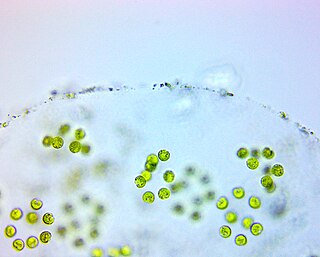
Chlamydomonadales, also known as Volvocales, are an order of flagellated or pseudociliated green algae, specifically of the Chlorophyceae. Chlamydomonadales can form planar or spherical colonies. These vary from Gonium up to Volvox. Each cell has two flagella, and is similar in appearance to Chlamydomonas, with the flagella throughout the colony moving in coordination.

The glaucophytes, also known as glaucocystophytes or glaucocystids, are a small group of unicellular algae found in freshwater and moist terrestrial environments, less common today than they were during the Proterozoic. The stated number of species in the group varies from about 14 to 26. Together with the red algae (Rhodophyta) and the green algae plus land plants, they form the Archaeplastida.

AlgaeBase is a global species database of information on all groups of algae, both marine and freshwater, as well as sea-grass.

Pyramimonadales are an order of green algae in the Chlorophyta. The chloroplasts of phototrophic euglenids probably came from endosymbiosis with a member of this order.
Oocystaceae is a family of green algae, in the order Chlorellales. The type genus is Oocystis.

The Tetrasporaceae are a family of green algae, specifically of the Chlamydomonadales. They are found in freshwater habitats.
Chlorococcum is a genus of green algae, in the family Chlorococcaceae. The alga may be useful in the flocculation of lipids from wastewater. It can be found in fresh water, but is more commonly found in soil or subaerial habitats.

Kirchneriella is a genus of green algae in the family Selenastraceae. It is found in freshwater habitats, as phytoplankton or metaphyton.

Micractinium is a genus of green algae in the family Chlorellaceae. Species of the genus Micractinium are common in freshwater habitats. A few species are found as endosymbionts of protozoa, such as Micractinium conductrix and Micractinium tetrahymenae.

Paulschulzia is a genus of green algae, specifically of the family Tetrasporaceae.

Schroederia is a genus of green algae in the family Schroederiaceae. Schroederiaceae is a monotypic taxon; Schroederia is its only genus.

Schroederiella is a genus of green algae in the family Scenedesmaceae.
Treubaria is a genus of green algae, the sole genus in the family Treubariaceae. Treubaria is found in freshwater habitats and has a cosmopolitan distribution.

Actinochloridaceae is a family of green algae, in the order Chlamydomonadales.

Characiaceae is a family of green algae in the order Sphaeropleales. It contains epiphytic or planktonic algae that are unicellular or colonial. The cells are heteropolar, with basal and apical ends having different shapes. The daughter cells are often retained in the cell wall of the old mother cell, whose cell wall becomes gelatinized.

Radiococcaceae is a family of green algae in the order Sphaeropleales.

Cyanophora paradoxa is a freshwater species of Glaucophyte that is used as a model organism. C. paradoxa has two cyanelles or chloroplasts where photosynthesis occurs. Cyanelles are unusual organelles in that they retain a rudimentary peptidoglycan wall. The cyanelle genome of C. paradoxa strain LB 555 was sequenced and published in 1995. The nuclear genome was also sequenced and published in 2012.
Chlorolobion, sometimes spelled Chlorolobium, is a genus of algae belonging to the family Selenastraceae. The species of this genus are found in freshwater habitats in Europe and America.














